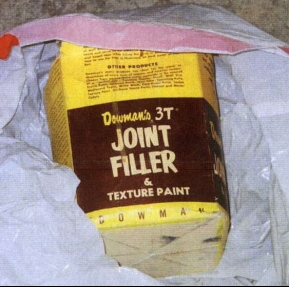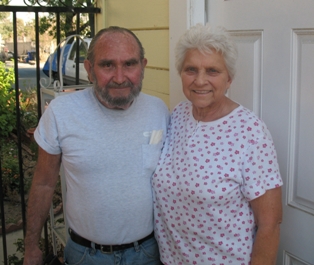Buyer Beware: What The Asbestos Companies Don't Tell You
The medical literature often repeats the statistic that 80% of all mesotheliomas diagnosed in the U.S. are caused by asbestos. The other 20%? It's not clear. Literally. The fancy word the researchers use to describe this lot is "idiopathic," which translates roughly as "unknown cause."
What if the patient doesn't know if he or she was exposed? What if although the patient doesn't know, it turns out he or she was exposed? Would the cause of the latter's mesothelioma still be "unknown?"
The clinical data regarding exposure usually arises from a brief interview between the doctor and the patient. A doctor will ask a patient if he or she was exposed and whatever answer the latter gives is usually the end of the story. This is understandable. The doctor has a lot of ground to cover in a short amount time, such as the patient's medical history, diagnosis, staging, performance status and treatment options. As a reference point, consider that in litigation defense lawyers can spend up to two to three weeks interrogating the patient about his or her asbestos exposure history.
The simple truth is many patients don't know about their asbestos exposure because many of the companies who put asbestos in their products didn't tell anyone. The manufacturers did not put warnings on their boxes and bags. Nor did they disclose on the packaging that "asbestos" was used as an ingredient.
Asbestos fibers were incorporated in over 5,000 products in the US prior to 1980, but only a handful of manufacturers disclosed that fact, and not a single manufacture warned that even tiny exposures could cause mesothelioma. It's not surprising then that a mesothelioma patient in a 40 minute medical consultation would be hard pressed to inventory all of his or her asbestos exposures over the past 25 to 50 years.
Buyer Beware!
The consequences of a company failing to warn or disclose was illustrated in a recent case filed in Los Angeles. Along with co-counsel, we represent Patricia Crawford, a 72 year old widow who resides in Fontana, California.
Patricia was diagnosed with pleural mesothelioma in September, 2007. She met with thoracic surgeon Dr. Robert Cameron on October 2, 2007. Patricia worked for a brief time at a steel mill as a bookkeeper. When Dr. Cameron asked her about her asbestos exposure, she answered that she had worked at the steel mill, although she didn't work with any asbestos products.
She didn't talk about her use of joint compounds on home repair and remodel projects back in the 1960s and 1970s. The thought did not occur to her at the time that the joint compounds contained asbestos.
When we met with Patricia and her husband Chuck at their home in Fontana about a month after Patricia's diagnosis, we asked whether they had ever remodeled their home or repaired cracks or holes in the walls. When they informed us that they had, we asked if they could recall any of the brand names of drywall products that they used.
What's Lurking in Your Garage?
Chuck answered by offering to show us a sample of the very same joint compound he used over thirty years ago. Chuck escorted us out to his garage, which was cluttered with the usual stuff an active family collects over several decades. He pulled down from a high shelf a box of Joint Filler. We knew from legal discovery that the manufacturer of this drywall product had admitted to using asbestos in the product until 1975, but the disclosure was not printed on the box.

We retrieved the box and sent it to a laboratory for asbestos content testing. The laboratory found asbestos. Unfortunately, Chuck passed away four months later from a long-standing respiratory illness. He died before he was able to testify about his use of the joint filler in Patricia's presence.
The manufacturer of the joint compound defended the case by attempting to pin the blame on Patricia's work at the Steel Mill, where, again, she worked inside an office as a bookkeeper. The manufacturer was unable to produce a witness who could testify that Patricia did, in fact, work with or around asbestos dust at the mill. On the other hand, Patricia had testified in her deposition that she assisted her husband with the joint filler on home remodeling and repair projects and, in so doing, inhaled dust that was generated during the mixing, sanding and clean up.
Why in the World Would They Put Toxic Asbestos in Drywall Paste?
The case eventually settled a few days into trial. Patricia is relieved that her case has resolved, but continues to be troubled about the circumstances of her exposure. She learned during the lawsuit that asbestos was not even a necessary ingredient in the joint fillers she used. Asbestos wasn't used because of its insulation properties. It was used mainly because it was cheaper than other binding agents.
Patricia shudders to think about the millions of other housewives out there who, like her, were exposed to dust from joint compounds used around the home. The products were marketed as easy to use by housewives, but the containers never warned that even casual use could decades later result in cancer or mesothelioma. "I never saw skull and crossbones," Patrica reflects wearily. "I never saw the words 'cancer' or 'mesothelioma'. I never even saw the word 'asbestos.'"
"We were conservative people. We saved everything, especially if there was a chance we'd need it again. How many other families, just like ours, kept old bags of joint compounds?" The spector of continued deadly exposures worries Patricia. "How many families are continuing to use joint compounds today that were bought decades ago that have asbestos in them, without anybody knowing?"
"How many people have already died from this? How many other housewives are out there with asbestos fibers in their lungs from using these joint fillers? My children used them too. By the time the poisoning turns into cancer, it's usually too late."
Dr. Cameron: " A Blessing"
Patricia is thankful that she found Dr. Cameron. "He has been a blessing." When Patricia was initially diagnosed by doctors at Kaiser Permanente, they tried to steer her into having her lung removed using the radical lung-amputating extra-pleural pnuemonectomy (EPP). She was not made aware of the lung-sparing pleurectomy-decortication (P/D) surgery and probably would've consented. But, thanks to the diligence and curiosity of her children, who logged onto the internet and discovered Dr. Robert Cameron, she sought a second opinion.
Undaunted by the lack of a formal referral from Kaiser Permanente, Patricia set up an appointment with Dr. Cameron. She knew that Kaiser's vast bureaucracy would either delay or reject the referral, but time was short. She decided to pay for the consultation herself and worry about coverage later.
Dr. Cameron talked with her extensively about her surgical options. He explained the differences between the EPP, which removed the lung, and the P/D, which spared the lung. He explained to her that the P/D provided the same tumor clearance as the EPP with a lower risk of mortality. He also explained to her the adjuvant use of radiation as well as immunotherapy and chemotherapy. Patricia ultimately chose to undergo the pleurectomy/decortication at UCLA on January 10, 2008. The doctors at Kaiser, who recommended the EPP, had not even mentioned the PD as an option.
After Surgery and Radiation, Now considering Interferon
After her full recovery, Patricia began radiation therapy with Dr. Michael Selch at UCLA in February. Her last of a total of 25 radiation treatments was performed in April, 2008. Patricia is still under Dr. Cameron's care and is scheduled to see him in January. She always looks forward to seeing Dr. Cameron because not only is he brilliant but he "tickles the wits out of me."
Patricia is currently considering interferon injections. She's even consulted with a diabetes healthcare provider to learn how to self-inject if she were to administer her interferon injections. Patricia is aware that interferon injections need to be taken for the rest of her life and is a little weary about "rocking the boat" too much at her age. She's been through a lot this past year and has recovered beautifully. Her pain is gradually subsiding, her appetite is strong and she enjoys exercise. She goes out for a walk everyday and tries to push herself a bit further every time even when she gets out of breath.
It Takes A Team
On the litigation front, Patricia couldn't be more pleased at how her case turned out. She jokes that her two dynamic trial attorneys, Chris Panatier and Stuart Purdy, were younger than her grandkids, but wise beyond their years. She's at a loss of words to express how grateful she is when it comes to the excellent representation she received. "I didn't have the vaguest clue where to start after I was diagnosed. I've been treated so well by everyone that's it been a pleasure." During her trial testimony, Patricia was fortunate enough to always be surrounded by friends and family. Two car loads of people joined her in her daily trips to the courthouse in downtown Los Angeles. She also appreciated the information she learned from expert witnesses, Dr. Brody and Dr. Holstein. "I learned more about mesothelioma than I ever wanted to learn. It was fascinating but sad, too."
These days Patricia has a lot to live for. She keeps reaching many milestones in her family that she didn't think were possible after she was diagnosed. Already, she's been to one grandson's wedding and witnessed the births of two great-grandchildren. There's another grandson's wedding in April and "I've gotta be there for that." In a few months, Patricia is taking a cruise to Hawaii with her best friends and her family is encouraging her to take many more trips. In the meantime, she's immersed in many household projects and chores.
Tragically, it's been nine months since Chuck, her husband of 42 years, passed away. She's thankful of the life they had together and has no regrets but, of course, she wishes that they had had a lmore time together.
Recently, one of Patricia's projects included cleaning out her garage. She admits to "a creepy feeling" every time she steps into her garage and reflects on the fact that they had been unwittingly storing a toxic cancer- causing poison for all those years.
In some ways, Patricia's exposure is unremarkable. Millions of Americans were exposed in a similar way - mixing, applying, sanding and cleaning up after the use of household joint fillers and drywall compounds. The question lingers - how many other garages out there have boxes of asbestos containing joint compounds in them? How many families continue to use and inhale its toxic dust? Who would ever think to have those old boxes tested for asbestos content? How many more consumers have been both deceived and poisoned by this pernicious product?
*** POSTED NOVEMBER 20, 2008 ***

An Update -- 3/2/2010
Patricia is tackling one thing after another on her “to-do list”. She recently oversaw her kitchen remodel and next plans to have new carpeting installed in her living room. She appreciates her ability to undertake projects that directly impact her quality of life, even when simply relaxing at home.
When she is not enjoying her updated home, she is jet-setting from one state to another visiting her growing family across the U.S. Her whole family is constantly vying for her company, “They’re hard to keep up with, but even harder saying ‘no’ to!” When not busy with family, Patricia also maintains close friendships. She regularly attends plays and movies with her friends and is looking forward to a “fall foliage tour” in Amish Country, Pennsylvania in October.
On the treatment front, Patricia recently had four cryoablation treatments with Dr. Fereidoun Abtin of UCLA in January. She has three more treatments scheduled this month. She adores Dr. Abtin and his “wonderful sense of humor”. According to her, the hardest part about undergoing cryoablation is lying motionless for hours, however Dr. Abtin seems to make this more tolerable.
Patricia continues to defy the odds of her condition. “It takes me longer to do the things I want to do, but I am doing very well”. Since her neighborhood is not very walking-friendly, lately Patricia has been building strength and balance with her new Wii Fit. Recently when one of her grandchildren had a go-cart racing birthday, Patricia momentarily considered partaking in the fun but in the end decided her knees would feel too cramped in a little go-cart. As she longingly watched from the sidelines, she promised not to deny herself next time and that her grandkids better watch out for her notorious “lead foot”!
An Update -- 5/15/2012
On May 12, 2012, Patricia spoke at the at the 2nd International Symposium on Lung-Sparing Therapies for Malignant Mesothelioma in Santa Monica, California. The symposium, which featured an international panel of medical specialists as well as a number of advocates, patients and family members, focused on lung-sparing treatment options for patients with malignant pleural mesothelioma.
Patricia had undergone a lung-sparing pleurectomy/decortication (P/D) surgery in January of 2008 performed by the symposium chair, thoracic surgeon Dr. Robert Cameron. On the eve of the fifth anniversary of her diagnosis with pleural mesothelioma, Patricia was invited to provide the “Patient’s Perspective” on lung-sparing therapies.
Her initial doctors wanted to remove her lung and told her to go home and get her affairs in order; they told her that she had a year to live. Her children did some research and found Dr. Cameron online, and his alternative treatment options ultimately saved her life.
Patricia has had over 36 cryoblation procedures performed since then. Cryoablation is a minimally invasive procedure using controlled freezing to dissipate small tumors in a relatively safe and quick manner. With the use of a large needle, compressed argon gas is applied to the targeted tissue, killing the cells it touches.
Patricia says, “if it wasn’t for Dr. Cameron, I would have missed the last four or five great grandkids and at least four weddings”. From her seven children she now has twenty grandkids and sixteen great grandkids, and they don’t give her much slack. She had an ablation performed right before this past New Year’s Eve and still went to her daughter’s for a party! Her family has been very supportive; they always give her something to look forward to and keep her laughing.
Patricia enjoys quilting with her daughter, gardening, traveling to visit her growing family and is looking forward to an upcoming Mississippi River cruise.
She is not going to give up. “As long as Dr. Cameron and Dr. Abtin stick by me, I will keep giving it all that I have.”
*** Patricia Crawford passed away on November 10, 2013 ***


